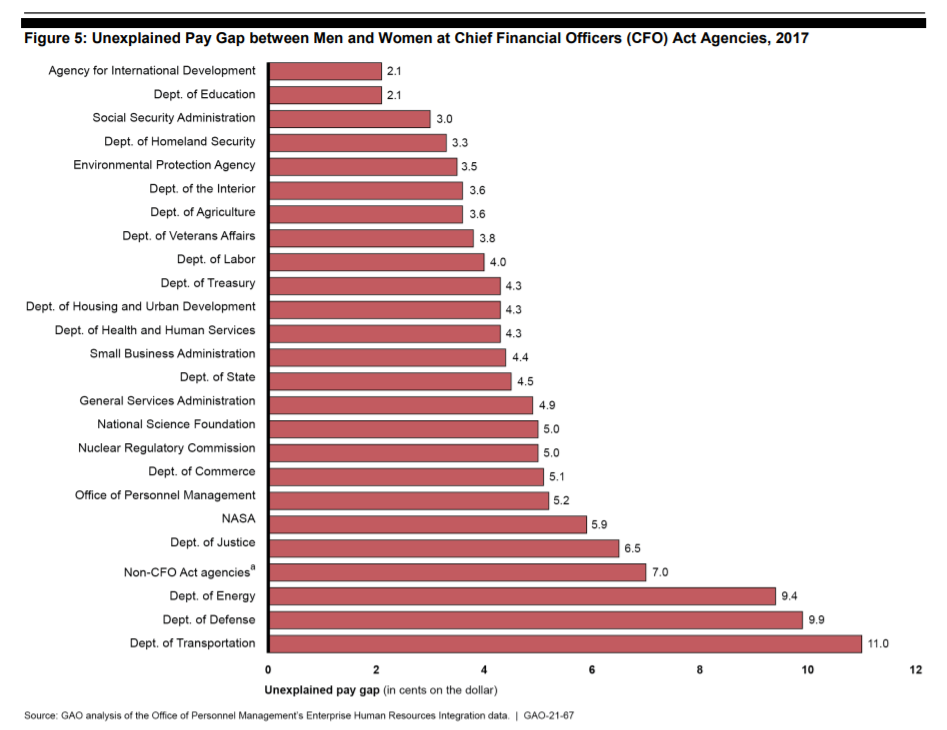
Explaining the ‘unexplained’ reasons for the gender pay gap in the federal workforce
Career choices, promotion opportunities and workplace flexibilities may explain why, on average, women in the federal workplace make 7% less than their male...
You might look at a recent report from the Government Accountability Office and wonder how, in 2020, a pay gap between men and women federal workers might still exist.
Not withstanding locality pay or special pay flexibilities that are unique to your own agency, pay raises (or freezes) are the same for all federal employees each year. Usually, you can find your salary for the year on a chart from the Office of Personnel Management.
But it’s not that easy.
On average, male federal employees made 7% more than their female colleagues in 2017, the most recent year for which data from OPM was available.
Put another way, women in the federal workforce earned 93 cents for every dollar earned by men in 2017. Women made an average of $80,213 that year, while men earned an average of $86,301.
That’s better than it was in 1999, when male federal employees made, on average, 19% more than their female colleagues, according to GAO.

The pay gap is down, in part, because men and women have become more similar in the workforce in some ways, GAO said. Men and women now have about the same amount of experience in the federal government. Plus, more women have left low-paying clerical positions and entered higher-paying professional and administrative jobs.
Women have also earned slightly higher rates of pay increases through things like performance bonuses and quality step increases.
A couple things to remember about all this:
First, this is average, and there’s some reasonably complex statistical analysis behind the pay gap figure. It doesn’t mean every male federal employee you meet will have a higher salary than any woman with a government salary.
Second, the pay gap between men and women in the federal workforce is, in fact, smaller than it is for the rest of the U.S. workforce. That’s partly because the government theoretically has systems and structures in place to ensure those with equal experience are paid for equal work.
A male GS-13, step 3 engineer in Philadelphia is supposed to make the same amount as a female GS-13, step 3 engineer in the same city.
GAO doesn’t dispute that, but it does point out there may be fewer female GS-13 engineers in the federal workforce than male engineers at the same grade level.
And that’s where things get tricky.
GAO goes on to explain how factors that aren’t typically captured in quantifiable data can and do contribute to pay disparities between male and female federal workers. In fact, GAO attributes much of the gender pay gap to these “unexplained factors.”
Take the rate of promotions or career choices as examples.
A federal employee with young children may take a job that has few travel obligations and more flexible work and telework arrangements but pays less than other jobs for which he or she might be qualified.
These kinds of scenarios are difficult to analyze, and OPM doesn’t keep data on an employee’s parental status.
It’s possible the paid parental leave program, which provides 12 weeks of paid time off for both new mothers and fathers, could contribute in positive ways toward narrowing the federal pay gap. But the most data GAO used for its analysis dates back to 2017, and the federal paid parental leave program kicked in two months ago.
Discrimination can also play a role, GAO said. Whether they’re conscious of it or not, agencies may tend to choose women for certain occupations and men for others.
GAO also pointed to data that shows the pay gap is wider still for Black, Hispanic and Alaska Native/American Indian women.
Black women, for example, made 12% less than white men, while Hispanic or Latina women made 9% less than white men.

Plus, there are unexplained factors that contribute to pay gaps between men and women at specific agencies, and those disparities vary depending on the organization.
Men at the Transportation Department, for example, make 11% more than women at the agency, outranking even the Defense Department, where the pay disparity is 9.9%.
The U.S. Agency for International Development and Education Department are tied for the lowest pay disparity, with men making 2.1% more at those agencies compared to women.

Part of this is due to the fact that men are simply employed at higher rates at certain agencies (like Transportation and Defense) than others.
Still, is it surprising to see men made up 74% of the Transportation workforce in 2017?
For me it is, but I’ve never worked there. And this isn’t necessarily a new development. According to recent data, 77% of the employees Transportation hired within the last five years are men, compared to just 23% of women.
For purposes of comparison, men made up 67% of the Defense workforce in 2017. Roughly 65% of its new hires within the last five years were men.
Bottom line, there’s no quick and easy explanation for the gender pay gap in the federal workforce, but slowly over time, it may disappear.
Nearly Useless Factoid
The Oxford Dictionary made “selfie” its word of the year in 2013, but by that point the concept had already existed for 174 years. Robert Cornelius took the first selfie in 1839. The camera’s exposure took so long, he was able to uncover the lens, run around the camera and sit for the photo for one minute, then re-cover the lens himself.
Source: Public Domain Review
Copyright © 2025 Federal News Network. All rights reserved. This website is not intended for users located within the European Economic Area.
Nicole Ogrysko is a reporter for Federal News Network focusing on the federal workforce and federal pay and benefits.
Follow @nogryskoWFED





